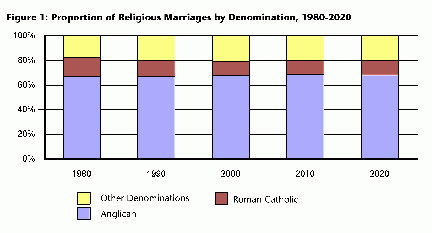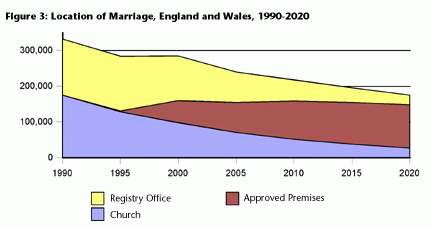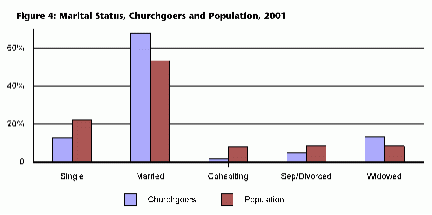Marriages, whether in church or a Registry Office, were not counted in the United Kingdom before 1837. In the nineteenth century, the majority of weddings took place in Anglican churches. Churches of other denominations gradually became licensed for marriage. Since then, the percent of marriages taking place in these churches has increased from 20% in 1900 to 33% by 2000. Recent and future proportions are graphed in Figure 1. Overall numbers still show dominance by the Church of England.

Church Weddings
It has been estimated that perhaps 10% of those getting married in Church of England churches are people within the church community. The other 90% are those using state church buildings and ministers for such occasions.
In his book Secular Lives, Sacred Hearts, Alan Billings suggests four reasons why people get married in a church:1
- Leaving behind the world of the non-married. Marriage is often seen not as a bond of intimate and individual relations, but as a rite of passage into a specific community. It is “the precursor to family life.”
- Deepening an established relationship. Most couples getting married today are already living together. According to Billings, marriage is seen partially as a “thanksgiving for their shared life to date”; however, it is also seen as a “fresh commitment to the future.”
- Establishing security and stability. Exchanging vows is seen as one way to guarantee the permanence and stability of the couple. “The vows make it clear that commitment in marriage is commitment to each other,” Billings writes, and that getting married in church is seen as a serious occasion.
- Committing in a “sacred place.” People want to get married in church because it is seen as a sacred and holy place. According to Billings, the church is a sacred place because “the rites…are Christian and (the couple) would count themselves as Christian, even though they never attend church.”
- 1995 government survey queried those who had been cohabiting but who were now getting married as to why they decided to make the commitment. Nearly 34% said they wanted to “make (the relationship) more secure.” Another 21% said they “wanted to have (or had had) children.”2
Declining Proportion
Church weddings do not just include existing churchgoers; religious marriages as a proportion of the total of all marriages in England have dropped from 60% in 1971 to 50% in 1991 to 36% in 2001. Marriage figures are collected by the government, who define a “religious” marriage as one taking place in a recognized place of worship. This is illustrated in Figure 2:

The decline in religious marriages is due to two factors: (1) the increasing number of second marriages (where one of the persons marrying had been married before and opts for a non-church ceremony the second time around) and (2) the opportunity to have the marriage service done on approved premises (alternative locations where marriages are licensed to take place), rather than in Registry Offices.
Of the two, the second is more important to what we are addressing. The proportion of second marriages increased from 37% of the total in 1991 to 40% in 2000. Some churches still do not allow the marriage of two people if a former partner of a previous marriage is still living. Consequently, most second marriages do not take place in a church and are therefore not counted as a religious marriage.
First marriages which are religious in England and Wales have dropped from 66% in 1991 to 48% in 2001.3 The majority of those marrying for the first time are in their twenties. Half of these couples wish to have a religious marriage, yet only 5.3% of individuals in that age group attend church. This is suggestive of a wider, if nominal, affiliation to Christianity.
Approved Premises
Approved Premises are often country houses, parts of the National Trust or quality hotels. However, with special permission, they can also be in more exotic settings such as the bottom of a swimming pool or on top of the wings of an aircraft flying at 150 mph! Such locations are especially attractive to those wanting something special, adventurous or unusual, or who feel that a Registry Office is too sombre or a church too uncomfortable. This is often the case with those starting second marriages.
Approved Premises were only introduced in 1995, yet are already proving popular. The proportion of marriages in approved premises grew from 17% of the total in 2000 to 24% in 2002. If present trends continue, more than half of all marriages may be done on approved premises by 2010. More than two-thirds may occur on these sites by 2020. Figure 3 shows that Registry Office and church weddings are declining.

Consequences of Cohabitation
Many people cohabit today. One consequence is that the average age at marriage for men and women is thirty and twenty-nine, respectively. Thirty years ago, men and women were getting married about five years earlier. Many church people also cohabit; the proportion of religious marriages where the couple cohabited before marriage was roughly 41% in 1994.4 This percentage has most likely increased since then.
Another consequence of cohabitation is that more people are living together and never marrying. Cohabitation is not seen (by some) as a “trial marriage,” but as a perfectly acceptable way of living. Nearly 12% of men and 10% of women aged thirty to forty-four cohabited in 1996. These figures increased to 16% and 14% respectively by 2001 and are likely to become 21% and 20% respectively by 2011.5
While many church people cohabit before marriage, relatively few continue to cohabit rather than get married at all. The marital status of church people is therefore different from that of the general population. This is shown in Figure 4.6

So What?
While many will continue to use the church for marriage, the percentage doing this is likely to decrease substantially over the next twenty years. Biblical teaching on the issues of marriage, betrothal and cohabitation needs to be re-emphasised in many churches. This is true even if those attending church are cohabitating but intending to marry. This issue will not go away in the next few years; rather, it will become an even more important reflection of the Christian lifestyle.

